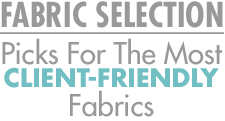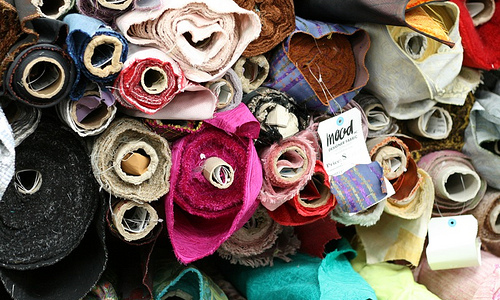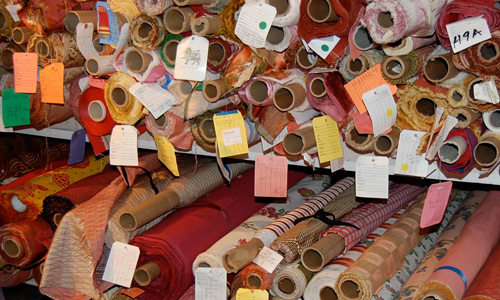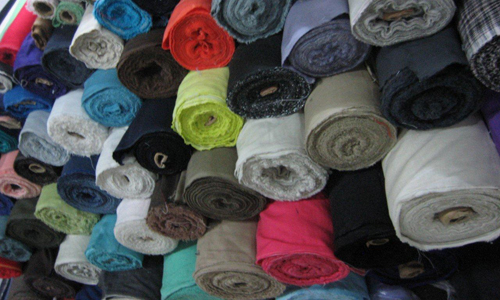
 contributed by The Folks at Fiber-Seal
contributed by The Folks at Fiber-Seal
As an interior designer, you need to create the WOW factor – to impress clients with your style and creativity. But WOW can turn into “What now”” when a fabric selection doesn’t perform well. Twenty-five yards of rayon velvet chosen for a family room sectional can quickly become a headache for both you and your client. Fabric selection involves so much more than color and texture. Making the right choice can be difficult because so often the information on the sample tag offers only fiber content – without any insight as to how the fabric will hold up in daily use.
Since we have made a 40-year career of helping your clients live comfortably with their fabrics, we’d like to offer some “real world” experience and insight on the easiest fabrics to maintain – with one major disclaimer. Our picks for the most “user friendly” fabrics have been carefully chosen and are based on our many years of experience in the maintenance of high-end fabrics. However, there is no single fabric that is right for every installation and no fabric is bulletproof!

What Makes A Fabric Serviceable”
The more cleaning options a fabric allows, the greater its serviceability. A fabric that is dry clean only makes both everyday care and overall cleaning challenging. Most spills are water-based and water-based spills can only be removed with water-based cleaners. Therefore, many stains remain uncleanable if only dry cleaning solvents can be used.
Because wet cleaning is far superior to dry cleaning for maintaining upholstery fabrics, we have seen over and over again that the ability to withstand at least some degree of wet cleaning is the hallmark of a more serviceable fabric.
It is also important to note that when a fabric is a blend of two or more fibers, it is usually necessary to maintain the fabric according to the weaker fiber. For example: Wool blended with nylon means you must treat the fabric as though it were all wool – which changes the cleaning options. If one of the least cleanable fibers is rayon, then no matter the other fibers and percentages, you probably will have to treat that fiber for use and care as you would a rayon.
Choose Silk Over Rayon
Rayon was originally created to imitate silk. Indeed, today’s rayon fabrics can look and feel very much like their silk counterparts. However, silk is generally much more serviceable than rayon, a fact that comes as a surprise to many (even those in the fabric business).
Many rayon upholstery fabrics are true “S” code (dry clean only) products, as water causes shrinking and rings. Rayon pile fabrics are the most difficult to maintain. Water distorts the nap and often the irregular pile cannot be corrected.
Silk, on the other hand, is more resilient and can usually be wet cleaned by professionals. The only downside to silk is its vulnerability to sun fading or, in the case of white silks, the aging/yellowing process known euphemistically as “patina.”

Consider Mohair For A More Durable Velvet
Mohair velvet is both elegant and surprisingly cleanable. This velvet does not suffer from the same serious nap issues that plague such fibers as rayon and linen.
Cotton Works Well In Many Constructions
Cotton fabrics as a group are better than average performers. Cleanability is excellent. In fact, during wet cleaning the fiber can actually strengthen by 20 percent. In contrast, rayon is 50 percent weaker when wet.
Cotton also works very well in velvet constructions and its natural appearance has stood the test of time. A couple of cottons we can’t recommend for high-use areas: light-colored canvas doesn’t usually clean well and denim can have crocking (colorfastness) issues.
Wool
Wool is not used as widely as other fibers in residential upholstery fabrics. Still, it is another natural fiber that holds up extremely well and is very serviceable.

Synthetic Suedes
Among the most forgiving fabrics, we would list the synthetic suedes (including Ultrasuede®, Novasuede®, generic “microsuede,” etc.). These fabrics offer a pleasing hand and tend to clean well.
Manmade Synthetics
The manmade non-cellulosic fibers such as nylon, acrylic, olefin, and polyester are generally durable and easy to maintain. Innovations in fiber chemistry have made them more attractive, more colorful and more like the natural fibers.
Note that we do not include the regenerated cellulosic fibers (which we call “manmade cellulosic fibers”) in this group. These excluded fibers are rayon (including most bamboo) and acetate, which are among the worst offenders to our ecosystem and the least serviceable of all the fibers.
We’re Here To Help
 Got a question about a fabric or floor covering” We are happy to answer it for you. Trust Fiber-Seal to provide the latest information about elegant interior textiles and their care. This article first appeared in Fiber-Seal System’s FIBERFAX Volume Twenty-One | Number Two. Copyright © 2011 by Fiber-Seal Systems. All rights reserved.
Got a question about a fabric or floor covering” We are happy to answer it for you. Trust Fiber-Seal to provide the latest information about elegant interior textiles and their care. This article first appeared in Fiber-Seal System’s FIBERFAX Volume Twenty-One | Number Two. Copyright © 2011 by Fiber-Seal Systems. All rights reserved.


